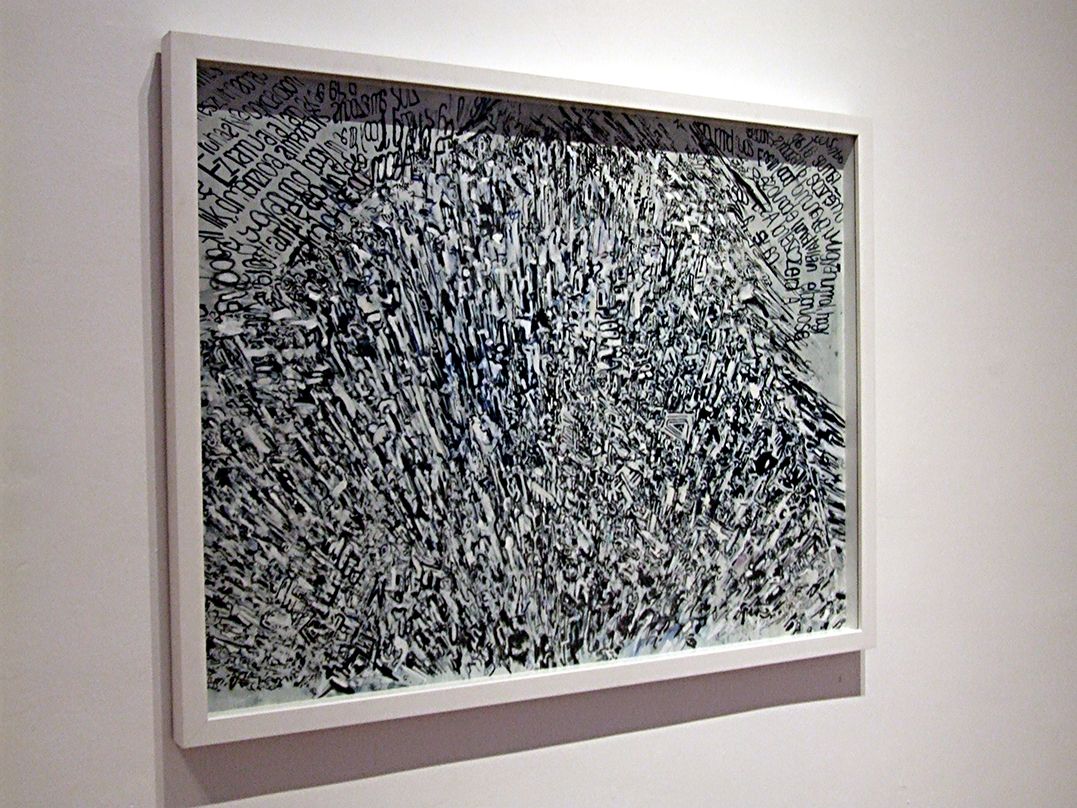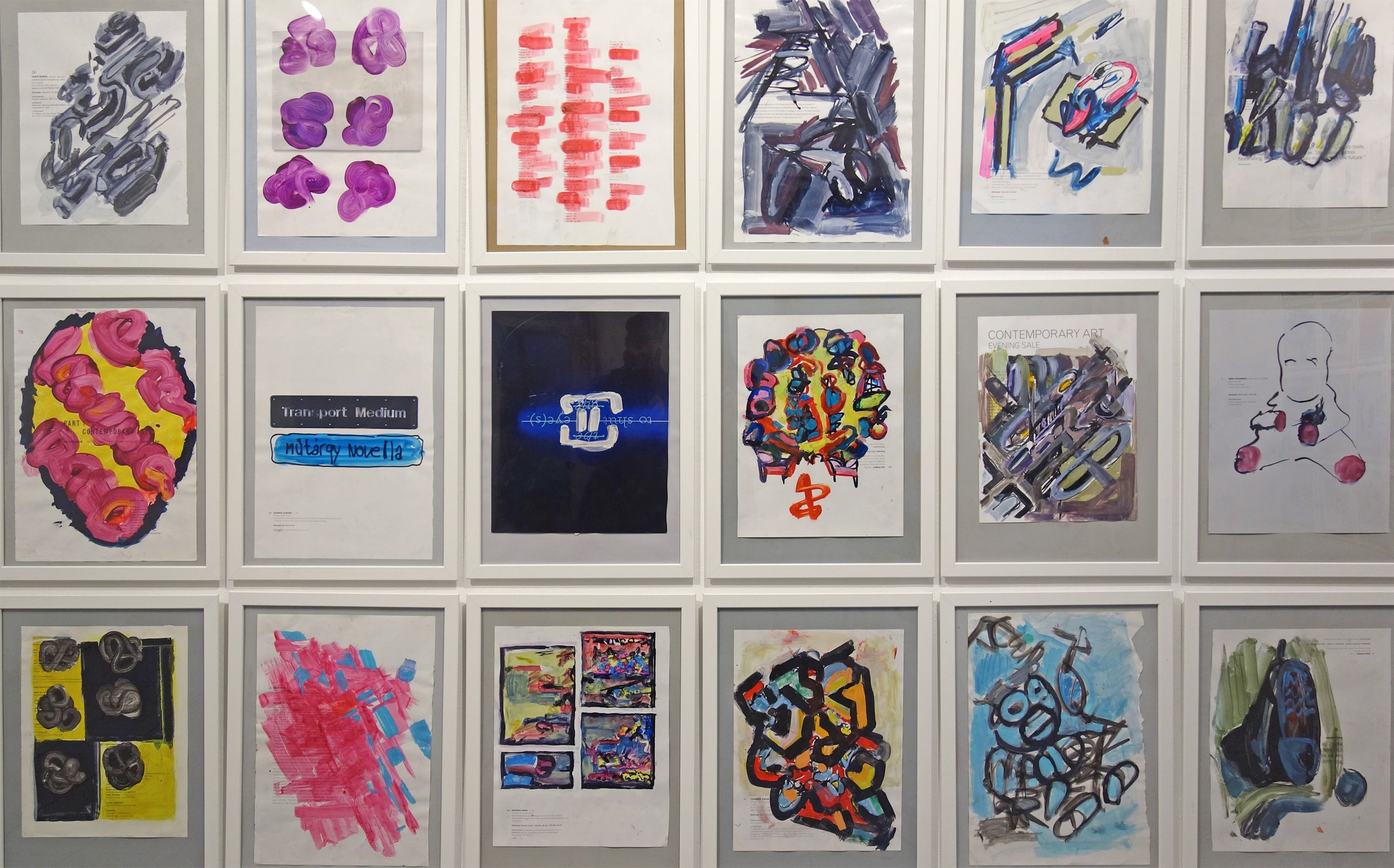Csaba Uglár
Between the Lines
| Venue: | acb Gallery |
| Date: | Nov 23 – Dec 21, 2012 |
Description
Csaba Uglár’s exhibition presents the newest part of his oeuvre, with works created mainly in the past two years, which represent a hyper-active and hyper-productive period in the artist’s career. This period of time highlights a clear turn towards painting, towards experimentation with the medium of painting, as his new works are exclusively paintings of various sizes on various paper formats, and sometimes on canvas. With these new works, Uglár set a platform for creating a new and unique visual language. While some works seem surprisingly new, his paintings from 2011 and 2012 could also be read as a synthesis of previous methods. In this way, they can be seen as connected to – and viewed in the context of – already existing pieces.
The project entitled “The Flow of Alien Consciousness”, a toxic mixture of still images and motion pictures that reflect on the utopia of machines rising to self-awareness can clearly be regarded as a predecessor, inspirational source, sketch – or visual pool if you like – of the exhibited series. More precisely, Uglár wanted to create an artistic automaton, which creates art without any human intervention. The self-sufficient cellular automata, the fractals, and other images descending from mathematical and geometrical formulas, which bear the promise of infinite variability and the automatic generation of images, create structures and visual patterns that are often associated with images in visual art. While these images don’t need strong inputs from outside the computer, the mechanized projection nevertheless became an extension of the artist’s ego and body. Uglár’s analog pictures derived from this methodology, however, follow another route. The compositional and constructional skeletons, which originate mostly from the display surface of the computer (thus most of the images have the same horizontal scale as a monitor), go through an inverse process, as they are being projected onto their physical medium by the artist, his consciousness and his automatic gestures. Thus, the paintings bear more of Uglár’s personal marks, they are more flesh and blood in every sense, than his previous digital images, which were more akin to pixel and display errors in large part originating from cellular automata – or, in other words, biological simulations.
Another very important component of Uglár’s new paintings is character-architecture or typography-construction, which was introduced to his practice through his previous work, entitled “Hidden Character”. The system of encrypted Latin letters is re-anthropomorphized in this work by a fusion of figurativeness and abstraction. The connections reach a new subatomic level in the body of the new paintings, as Uglár unites the infinite aesthetics of cellular automata and fractals through a covalent bond with the neo-constructivist concrete poetry of his text-architecture.
As the above discussion already indicates, it is not possible to offer a technocratic recipe for decoding Uglár’s works. His new paintings require an extreme measure of empathy from the viewer. This relation, in essence, stems from the extraordinarily personal nature of the bond between the artist and his works, which also becomes projected onto the viewer at the exhibition.
It could be said that Uglár is reconstructing Tatlin’s “Tower of Babel” from the utopia of words, recreating the activist typography of the classical avant-garde with the unique postmodern attitude of a technocrat. Still, the real secret formula behind the pictures is the painterly attitude of the artist. Uglár reverses his text assemblages to calligraphy. This allusion to the psychedelic typography of visual culture in the ‘60s and ‘70s is further amplified in his images, rendering the painterly aspects of the text explicitly dominant. The status of the letters on Uglár’s paintings is altered from that of a code to that of a concrete object, while text reoccupies the territory of sensuality that it abandoned when symbolic meanings were attached to it. It is at this point, when abstract code once again becomes abstract, that Uglár really begins to approach painting, whose system of gestures he only seemed to have suspended temporarily in the first place. Uglár ‘s latest paintings are connected to such early works as “Plexuality” and “Stealth”, or even to his paintings depicting movie casts, which represent a different branch of transfusing visuality and text. The body of the present works created on black paper is most reminiscent of his paintings with ball bearings inserted into a black painted surface.
Csaba Uglár’s painting is an experiment to create a system without clear borders or rules – in essence, a system without a system. It is a contradiction at its base. Thus his work is an anarchic formula of the chaos theory, which invites us for time-travel in typography. It is as much poetry as it is gesture and action painting, fuelled by the monologues of the ego. It is both auto-therapy and automatism, which to the viewer may often manifest as mania. If we wish to remain less auto-biographical and more poetic, however, we could say that the paintings are electro-technical modulations channeled into calligraphic painting. Of course, this always comes together with a dose of – instinctively postmodern – “bad painting”, which has always been characteristic of Uglár’s work and artistic production.
Entropy – a rather magical word – can also be offered as yet another keyphrase of interpretation, which causes this visual universe to function as a black hole, swallowing many kinds of letters, broken sentences, lines of poetry, and quotations. I find Uglár’s paintings most comparable to a big sponge which absorbs everything crossing its path – colors, texts, materials, and dirt – rendering readable on the surfaces of the works the extremely versatile emotional palette of the last two years in the artist’s life, spanning from the banal to the deeply existential, with occasional breakouts steeped in the metaphysical.
The artist observes primarily himself, secondarily the system of his images: and he pushes the possibility of modulating his images to an extreme, almost unbearable level, which takes us to the outskirts of perception. Through the ghosts that wander between the lines, Uglár seeks to perceive, comprehend, observe and record that which is beyond the senses, while his works are but scratches engraved on the face of existence.
Áron Fenyvesi

